The Effect of Training on Employee Productivity: Ford Australia
VerifiedAdded on 2021/05/30
|16
|3877
|299
Project
AI Summary
This research proposal investigates the impact of training and development programs on employee productivity at Ford Australia. It explores the significance of training in enhancing employee skills, job satisfaction, and overall organizational performance within the dynamic automobile industry. The study addresses the management problem of determining the frequency and effectiveness of training programs, aiming to identify training needs and assess their impact on employee productivity. Research questions focus on the effects of training, key training areas, and barriers within the vehicle manufacturing sector. The objectives include determining the impact of training on productivity, identifying essential training areas, and uncovering barriers to training implementation. The literature review highlights the importance of employee productivity, the role of training in skill enhancement, and the impact of motivation and job satisfaction. The research design employs an explanatory approach, utilizing both qualitative and quantitative methods, including surveys, interviews, and analysis of secondary data. The study aims to provide insights into the cost-benefit analysis of training programs and contribute to the sustainability and competitiveness of Ford Australia.
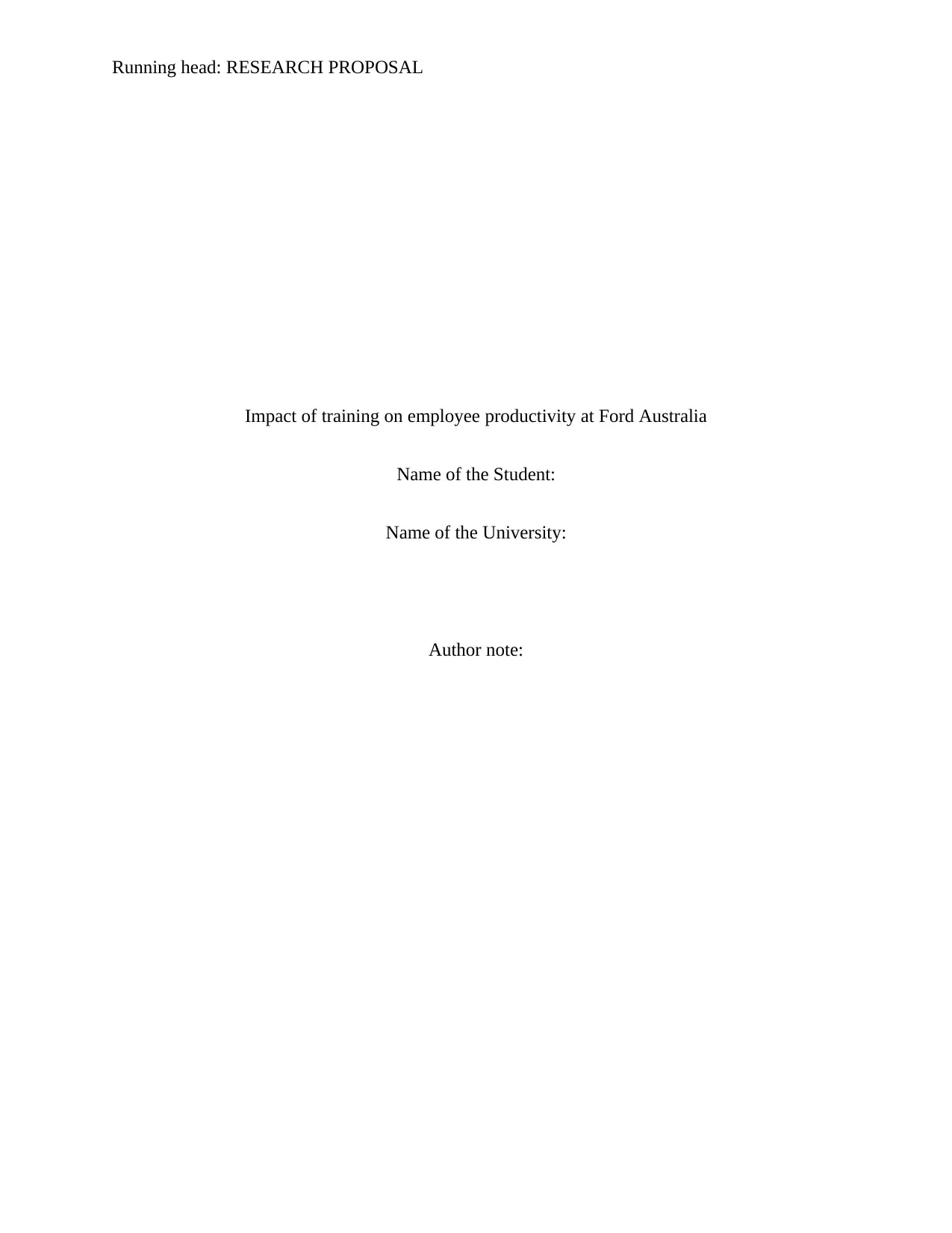
Running head: RESEARCH PROPOSAL
Impact of training on employee productivity at Ford Australia
Name of the Student:
Name of the University:
Author note:
Impact of training on employee productivity at Ford Australia
Name of the Student:
Name of the University:
Author note:
Paraphrase This Document
Need a fresh take? Get an instant paraphrase of this document with our AI Paraphraser
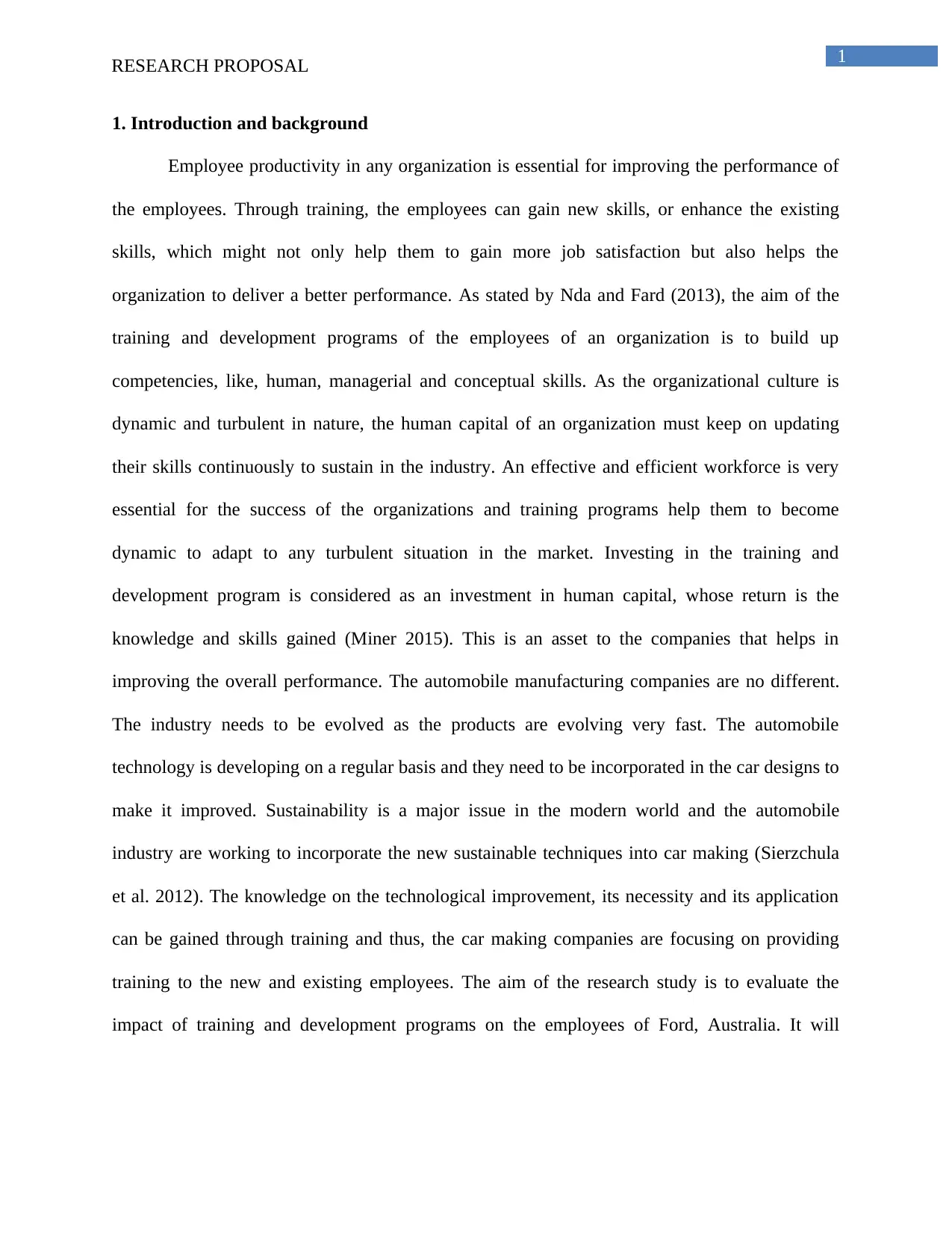
1RESEARCH PROPOSAL
1. Introduction and background
Employee productivity in any organization is essential for improving the performance of
the employees. Through training, the employees can gain new skills, or enhance the existing
skills, which might not only help them to gain more job satisfaction but also helps the
organization to deliver a better performance. As stated by Nda and Fard (2013), the aim of the
training and development programs of the employees of an organization is to build up
competencies, like, human, managerial and conceptual skills. As the organizational culture is
dynamic and turbulent in nature, the human capital of an organization must keep on updating
their skills continuously to sustain in the industry. An effective and efficient workforce is very
essential for the success of the organizations and training programs help them to become
dynamic to adapt to any turbulent situation in the market. Investing in the training and
development program is considered as an investment in human capital, whose return is the
knowledge and skills gained (Miner 2015). This is an asset to the companies that helps in
improving the overall performance. The automobile manufacturing companies are no different.
The industry needs to be evolved as the products are evolving very fast. The automobile
technology is developing on a regular basis and they need to be incorporated in the car designs to
make it improved. Sustainability is a major issue in the modern world and the automobile
industry are working to incorporate the new sustainable techniques into car making (Sierzchula
et al. 2012). The knowledge on the technological improvement, its necessity and its application
can be gained through training and thus, the car making companies are focusing on providing
training to the new and existing employees. The aim of the research study is to evaluate the
impact of training and development programs on the employees of Ford, Australia. It will
1. Introduction and background
Employee productivity in any organization is essential for improving the performance of
the employees. Through training, the employees can gain new skills, or enhance the existing
skills, which might not only help them to gain more job satisfaction but also helps the
organization to deliver a better performance. As stated by Nda and Fard (2013), the aim of the
training and development programs of the employees of an organization is to build up
competencies, like, human, managerial and conceptual skills. As the organizational culture is
dynamic and turbulent in nature, the human capital of an organization must keep on updating
their skills continuously to sustain in the industry. An effective and efficient workforce is very
essential for the success of the organizations and training programs help them to become
dynamic to adapt to any turbulent situation in the market. Investing in the training and
development program is considered as an investment in human capital, whose return is the
knowledge and skills gained (Miner 2015). This is an asset to the companies that helps in
improving the overall performance. The automobile manufacturing companies are no different.
The industry needs to be evolved as the products are evolving very fast. The automobile
technology is developing on a regular basis and they need to be incorporated in the car designs to
make it improved. Sustainability is a major issue in the modern world and the automobile
industry are working to incorporate the new sustainable techniques into car making (Sierzchula
et al. 2012). The knowledge on the technological improvement, its necessity and its application
can be gained through training and thus, the car making companies are focusing on providing
training to the new and existing employees. The aim of the research study is to evaluate the
impact of training and development programs on the employees of Ford, Australia. It will
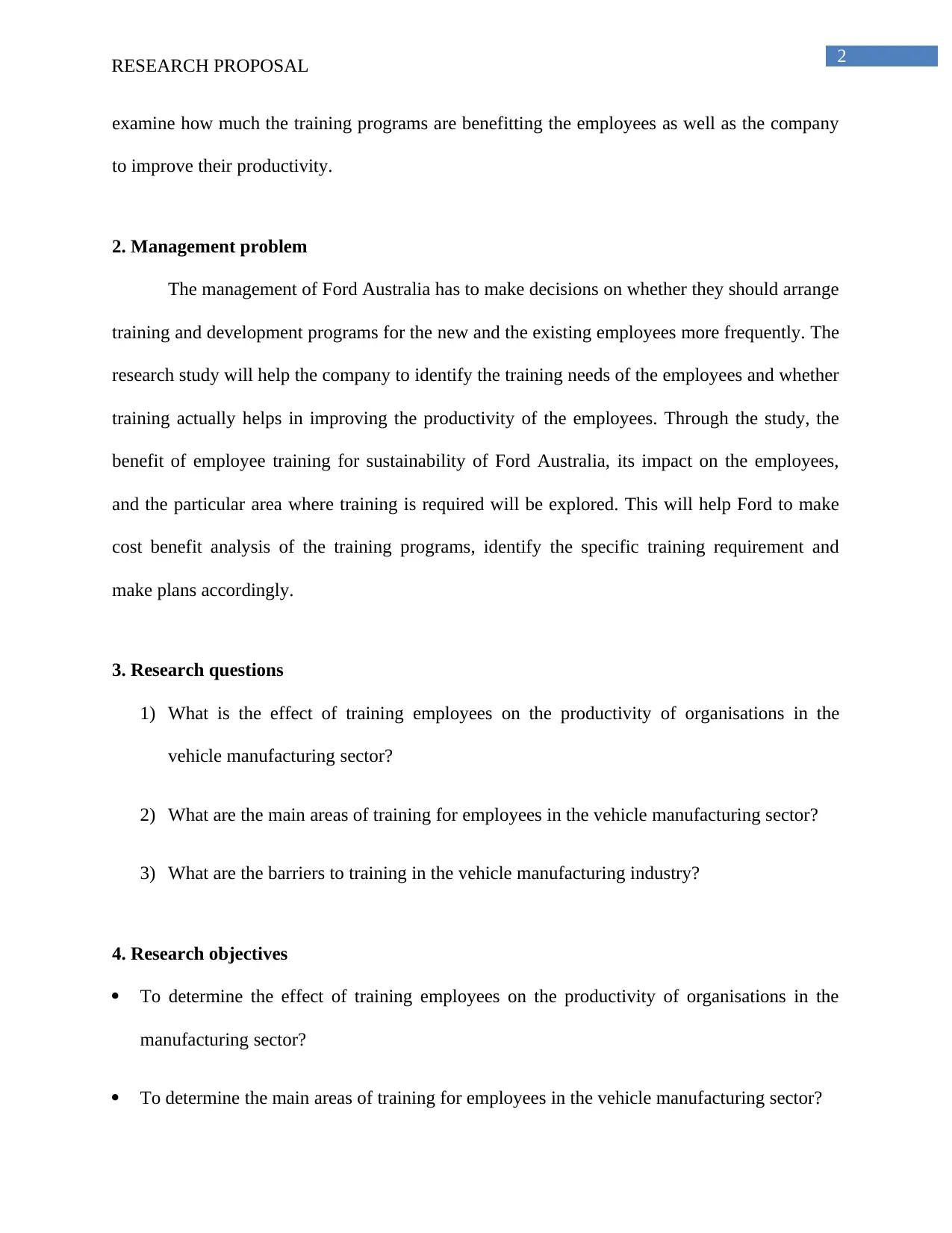
2RESEARCH PROPOSAL
examine how much the training programs are benefitting the employees as well as the company
to improve their productivity.
2. Management problem
The management of Ford Australia has to make decisions on whether they should arrange
training and development programs for the new and the existing employees more frequently. The
research study will help the company to identify the training needs of the employees and whether
training actually helps in improving the productivity of the employees. Through the study, the
benefit of employee training for sustainability of Ford Australia, its impact on the employees,
and the particular area where training is required will be explored. This will help Ford to make
cost benefit analysis of the training programs, identify the specific training requirement and
make plans accordingly.
3. Research questions
1) What is the effect of training employees on the productivity of organisations in the
vehicle manufacturing sector?
2) What are the main areas of training for employees in the vehicle manufacturing sector?
3) What are the barriers to training in the vehicle manufacturing industry?
4. Research objectives
To determine the effect of training employees on the productivity of organisations in the
manufacturing sector?
To determine the main areas of training for employees in the vehicle manufacturing sector?
examine how much the training programs are benefitting the employees as well as the company
to improve their productivity.
2. Management problem
The management of Ford Australia has to make decisions on whether they should arrange
training and development programs for the new and the existing employees more frequently. The
research study will help the company to identify the training needs of the employees and whether
training actually helps in improving the productivity of the employees. Through the study, the
benefit of employee training for sustainability of Ford Australia, its impact on the employees,
and the particular area where training is required will be explored. This will help Ford to make
cost benefit analysis of the training programs, identify the specific training requirement and
make plans accordingly.
3. Research questions
1) What is the effect of training employees on the productivity of organisations in the
vehicle manufacturing sector?
2) What are the main areas of training for employees in the vehicle manufacturing sector?
3) What are the barriers to training in the vehicle manufacturing industry?
4. Research objectives
To determine the effect of training employees on the productivity of organisations in the
manufacturing sector?
To determine the main areas of training for employees in the vehicle manufacturing sector?
⊘ This is a preview!⊘
Do you want full access?
Subscribe today to unlock all pages.

Trusted by 1+ million students worldwide
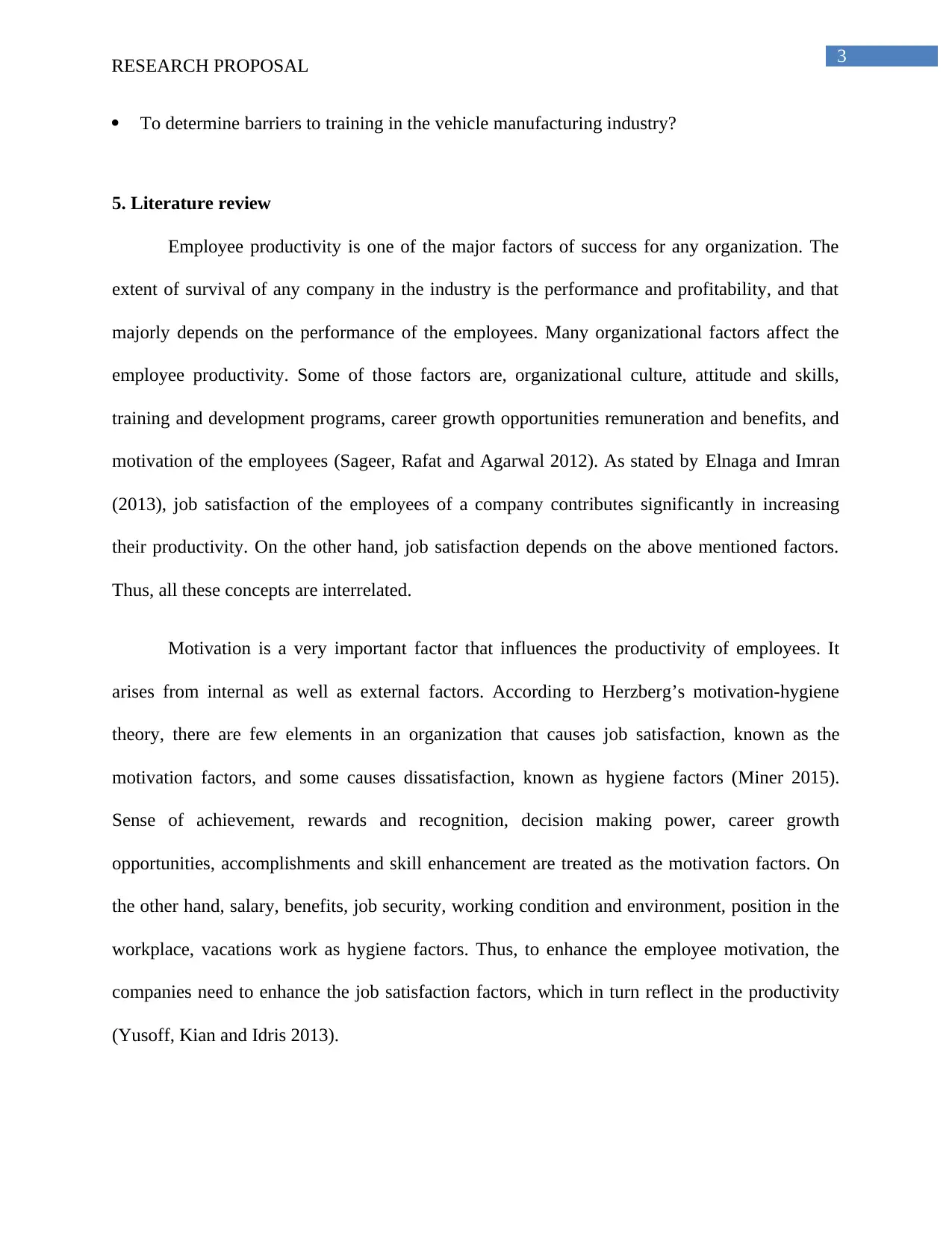
3RESEARCH PROPOSAL
To determine barriers to training in the vehicle manufacturing industry?
5. Literature review
Employee productivity is one of the major factors of success for any organization. The
extent of survival of any company in the industry is the performance and profitability, and that
majorly depends on the performance of the employees. Many organizational factors affect the
employee productivity. Some of those factors are, organizational culture, attitude and skills,
training and development programs, career growth opportunities remuneration and benefits, and
motivation of the employees (Sageer, Rafat and Agarwal 2012). As stated by Elnaga and Imran
(2013), job satisfaction of the employees of a company contributes significantly in increasing
their productivity. On the other hand, job satisfaction depends on the above mentioned factors.
Thus, all these concepts are interrelated.
Motivation is a very important factor that influences the productivity of employees. It
arises from internal as well as external factors. According to Herzberg’s motivation-hygiene
theory, there are few elements in an organization that causes job satisfaction, known as the
motivation factors, and some causes dissatisfaction, known as hygiene factors (Miner 2015).
Sense of achievement, rewards and recognition, decision making power, career growth
opportunities, accomplishments and skill enhancement are treated as the motivation factors. On
the other hand, salary, benefits, job security, working condition and environment, position in the
workplace, vacations work as hygiene factors. Thus, to enhance the employee motivation, the
companies need to enhance the job satisfaction factors, which in turn reflect in the productivity
(Yusoff, Kian and Idris 2013).
To determine barriers to training in the vehicle manufacturing industry?
5. Literature review
Employee productivity is one of the major factors of success for any organization. The
extent of survival of any company in the industry is the performance and profitability, and that
majorly depends on the performance of the employees. Many organizational factors affect the
employee productivity. Some of those factors are, organizational culture, attitude and skills,
training and development programs, career growth opportunities remuneration and benefits, and
motivation of the employees (Sageer, Rafat and Agarwal 2012). As stated by Elnaga and Imran
(2013), job satisfaction of the employees of a company contributes significantly in increasing
their productivity. On the other hand, job satisfaction depends on the above mentioned factors.
Thus, all these concepts are interrelated.
Motivation is a very important factor that influences the productivity of employees. It
arises from internal as well as external factors. According to Herzberg’s motivation-hygiene
theory, there are few elements in an organization that causes job satisfaction, known as the
motivation factors, and some causes dissatisfaction, known as hygiene factors (Miner 2015).
Sense of achievement, rewards and recognition, decision making power, career growth
opportunities, accomplishments and skill enhancement are treated as the motivation factors. On
the other hand, salary, benefits, job security, working condition and environment, position in the
workplace, vacations work as hygiene factors. Thus, to enhance the employee motivation, the
companies need to enhance the job satisfaction factors, which in turn reflect in the productivity
(Yusoff, Kian and Idris 2013).
Paraphrase This Document
Need a fresh take? Get an instant paraphrase of this document with our AI Paraphraser
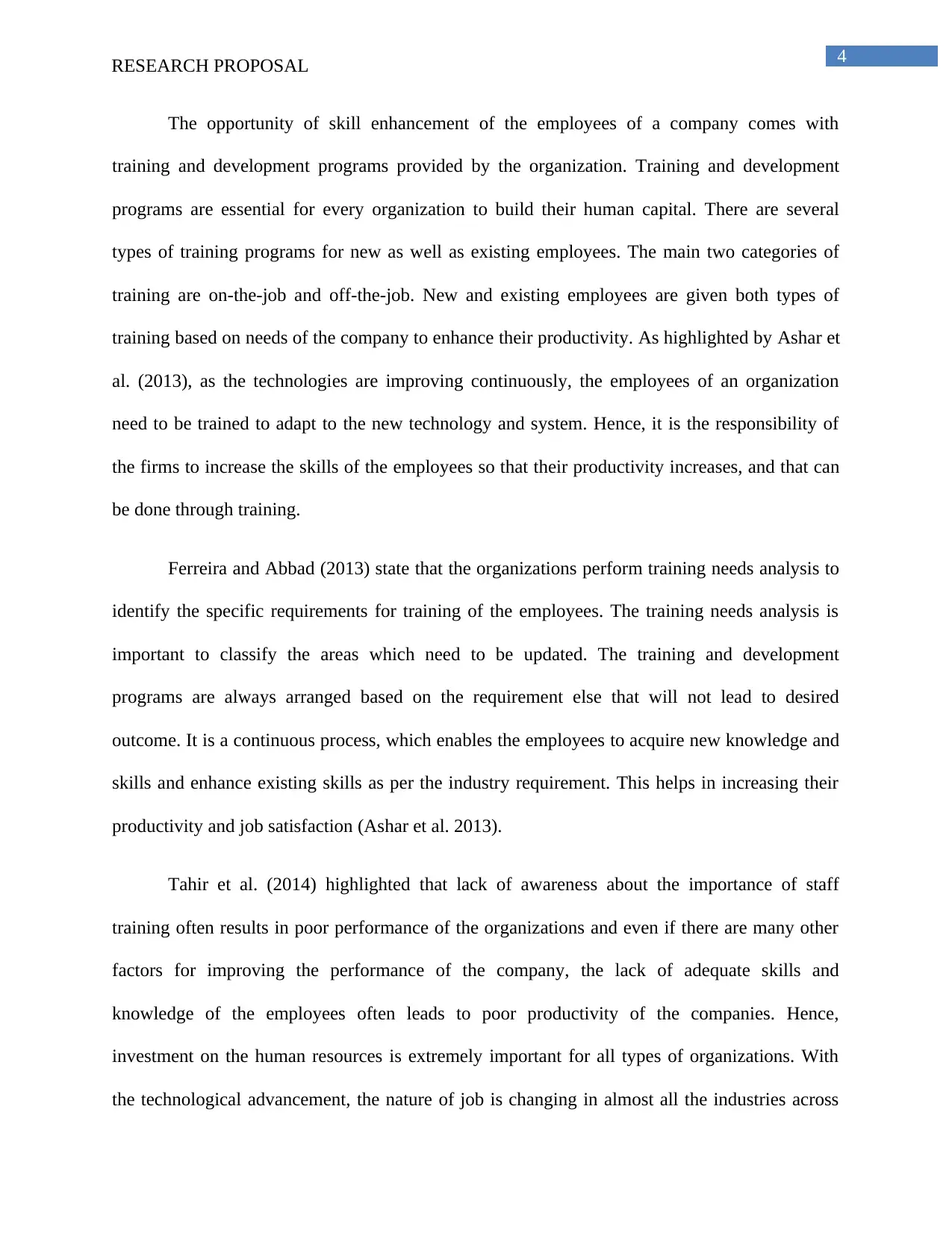
4RESEARCH PROPOSAL
The opportunity of skill enhancement of the employees of a company comes with
training and development programs provided by the organization. Training and development
programs are essential for every organization to build their human capital. There are several
types of training programs for new as well as existing employees. The main two categories of
training are on-the-job and off-the-job. New and existing employees are given both types of
training based on needs of the company to enhance their productivity. As highlighted by Ashar et
al. (2013), as the technologies are improving continuously, the employees of an organization
need to be trained to adapt to the new technology and system. Hence, it is the responsibility of
the firms to increase the skills of the employees so that their productivity increases, and that can
be done through training.
Ferreira and Abbad (2013) state that the organizations perform training needs analysis to
identify the specific requirements for training of the employees. The training needs analysis is
important to classify the areas which need to be updated. The training and development
programs are always arranged based on the requirement else that will not lead to desired
outcome. It is a continuous process, which enables the employees to acquire new knowledge and
skills and enhance existing skills as per the industry requirement. This helps in increasing their
productivity and job satisfaction (Ashar et al. 2013).
Tahir et al. (2014) highlighted that lack of awareness about the importance of staff
training often results in poor performance of the organizations and even if there are many other
factors for improving the performance of the company, the lack of adequate skills and
knowledge of the employees often leads to poor productivity of the companies. Hence,
investment on the human resources is extremely important for all types of organizations. With
the technological advancement, the nature of job is changing in almost all the industries across
The opportunity of skill enhancement of the employees of a company comes with
training and development programs provided by the organization. Training and development
programs are essential for every organization to build their human capital. There are several
types of training programs for new as well as existing employees. The main two categories of
training are on-the-job and off-the-job. New and existing employees are given both types of
training based on needs of the company to enhance their productivity. As highlighted by Ashar et
al. (2013), as the technologies are improving continuously, the employees of an organization
need to be trained to adapt to the new technology and system. Hence, it is the responsibility of
the firms to increase the skills of the employees so that their productivity increases, and that can
be done through training.
Ferreira and Abbad (2013) state that the organizations perform training needs analysis to
identify the specific requirements for training of the employees. The training needs analysis is
important to classify the areas which need to be updated. The training and development
programs are always arranged based on the requirement else that will not lead to desired
outcome. It is a continuous process, which enables the employees to acquire new knowledge and
skills and enhance existing skills as per the industry requirement. This helps in increasing their
productivity and job satisfaction (Ashar et al. 2013).
Tahir et al. (2014) highlighted that lack of awareness about the importance of staff
training often results in poor performance of the organizations and even if there are many other
factors for improving the performance of the company, the lack of adequate skills and
knowledge of the employees often leads to poor productivity of the companies. Hence,
investment on the human resources is extremely important for all types of organizations. With
the technological advancement, the nature of job is changing in almost all the industries across
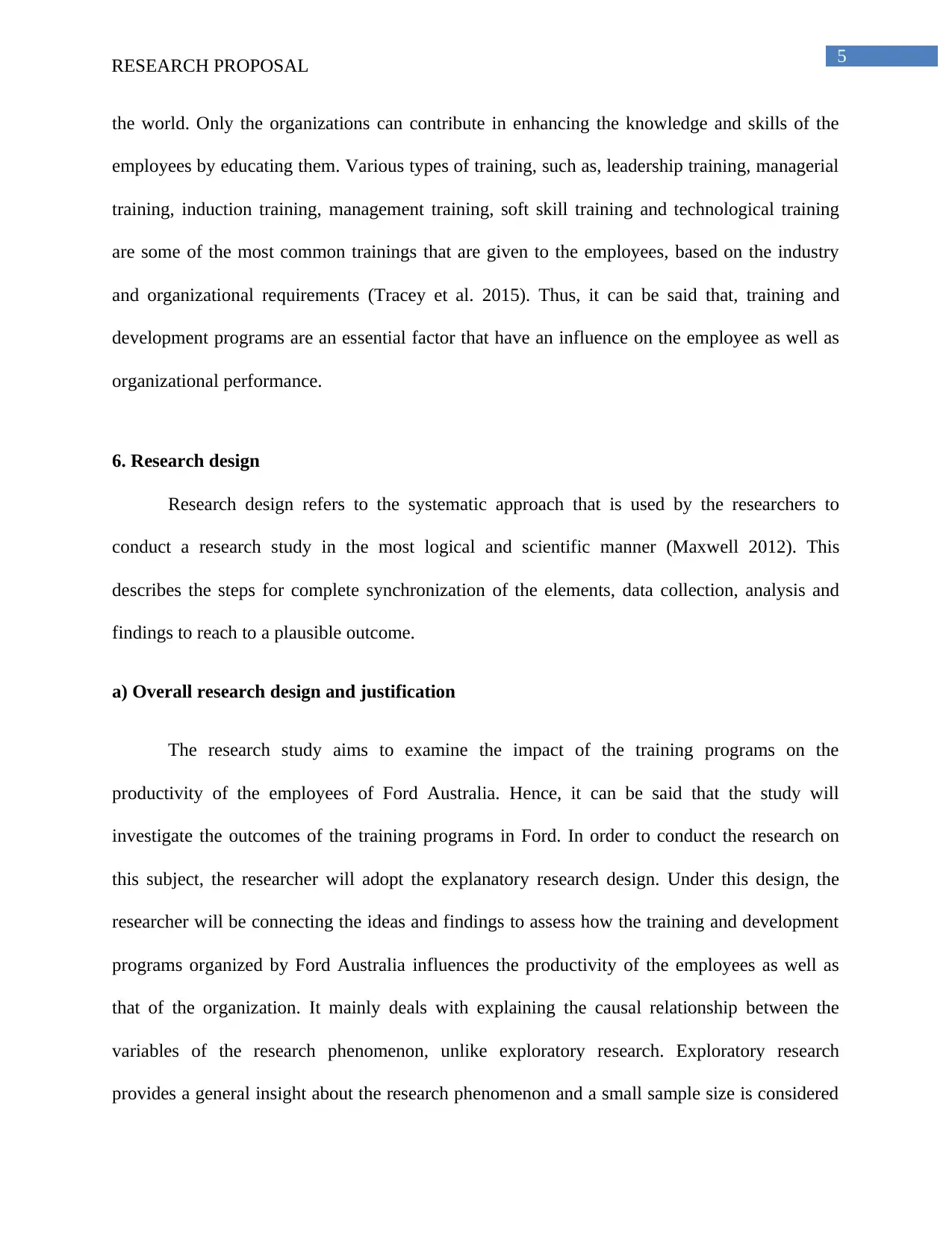
5RESEARCH PROPOSAL
the world. Only the organizations can contribute in enhancing the knowledge and skills of the
employees by educating them. Various types of training, such as, leadership training, managerial
training, induction training, management training, soft skill training and technological training
are some of the most common trainings that are given to the employees, based on the industry
and organizational requirements (Tracey et al. 2015). Thus, it can be said that, training and
development programs are an essential factor that have an influence on the employee as well as
organizational performance.
6. Research design
Research design refers to the systematic approach that is used by the researchers to
conduct a research study in the most logical and scientific manner (Maxwell 2012). This
describes the steps for complete synchronization of the elements, data collection, analysis and
findings to reach to a plausible outcome.
a) Overall research design and justification
The research study aims to examine the impact of the training programs on the
productivity of the employees of Ford Australia. Hence, it can be said that the study will
investigate the outcomes of the training programs in Ford. In order to conduct the research on
this subject, the researcher will adopt the explanatory research design. Under this design, the
researcher will be connecting the ideas and findings to assess how the training and development
programs organized by Ford Australia influences the productivity of the employees as well as
that of the organization. It mainly deals with explaining the causal relationship between the
variables of the research phenomenon, unlike exploratory research. Exploratory research
provides a general insight about the research phenomenon and a small sample size is considered
the world. Only the organizations can contribute in enhancing the knowledge and skills of the
employees by educating them. Various types of training, such as, leadership training, managerial
training, induction training, management training, soft skill training and technological training
are some of the most common trainings that are given to the employees, based on the industry
and organizational requirements (Tracey et al. 2015). Thus, it can be said that, training and
development programs are an essential factor that have an influence on the employee as well as
organizational performance.
6. Research design
Research design refers to the systematic approach that is used by the researchers to
conduct a research study in the most logical and scientific manner (Maxwell 2012). This
describes the steps for complete synchronization of the elements, data collection, analysis and
findings to reach to a plausible outcome.
a) Overall research design and justification
The research study aims to examine the impact of the training programs on the
productivity of the employees of Ford Australia. Hence, it can be said that the study will
investigate the outcomes of the training programs in Ford. In order to conduct the research on
this subject, the researcher will adopt the explanatory research design. Under this design, the
researcher will be connecting the ideas and findings to assess how the training and development
programs organized by Ford Australia influences the productivity of the employees as well as
that of the organization. It mainly deals with explaining the causal relationship between the
variables of the research phenomenon, unlike exploratory research. Exploratory research
provides a general insight about the research phenomenon and a small sample size is considered
⊘ This is a preview!⊘
Do you want full access?
Subscribe today to unlock all pages.

Trusted by 1+ million students worldwide
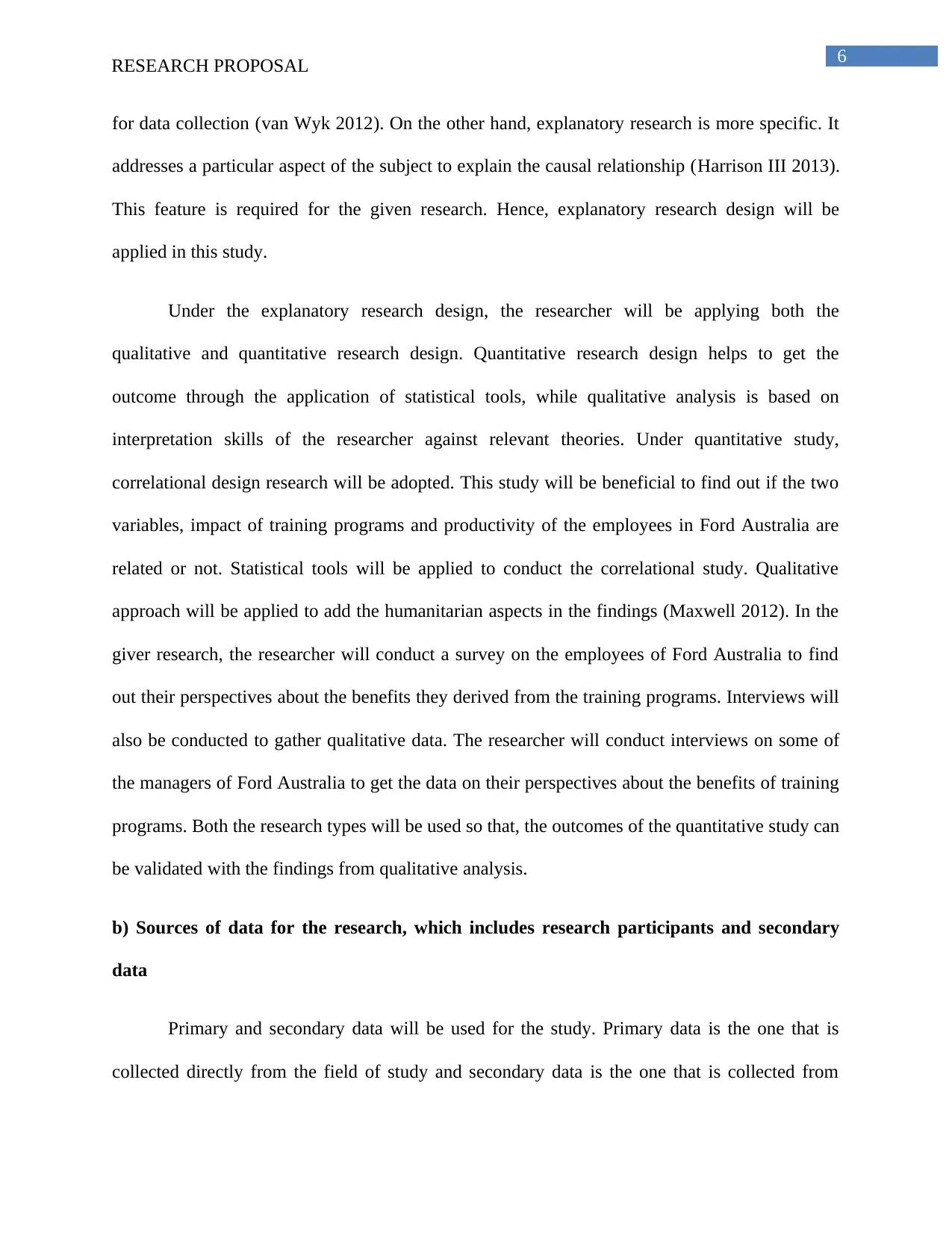
6RESEARCH PROPOSAL
for data collection (van Wyk 2012). On the other hand, explanatory research is more specific. It
addresses a particular aspect of the subject to explain the causal relationship (Harrison III 2013).
This feature is required for the given research. Hence, explanatory research design will be
applied in this study.
Under the explanatory research design, the researcher will be applying both the
qualitative and quantitative research design. Quantitative research design helps to get the
outcome through the application of statistical tools, while qualitative analysis is based on
interpretation skills of the researcher against relevant theories. Under quantitative study,
correlational design research will be adopted. This study will be beneficial to find out if the two
variables, impact of training programs and productivity of the employees in Ford Australia are
related or not. Statistical tools will be applied to conduct the correlational study. Qualitative
approach will be applied to add the humanitarian aspects in the findings (Maxwell 2012). In the
giver research, the researcher will conduct a survey on the employees of Ford Australia to find
out their perspectives about the benefits they derived from the training programs. Interviews will
also be conducted to gather qualitative data. The researcher will conduct interviews on some of
the managers of Ford Australia to get the data on their perspectives about the benefits of training
programs. Both the research types will be used so that, the outcomes of the quantitative study can
be validated with the findings from qualitative analysis.
b) Sources of data for the research, which includes research participants and secondary
data
Primary and secondary data will be used for the study. Primary data is the one that is
collected directly from the field of study and secondary data is the one that is collected from
for data collection (van Wyk 2012). On the other hand, explanatory research is more specific. It
addresses a particular aspect of the subject to explain the causal relationship (Harrison III 2013).
This feature is required for the given research. Hence, explanatory research design will be
applied in this study.
Under the explanatory research design, the researcher will be applying both the
qualitative and quantitative research design. Quantitative research design helps to get the
outcome through the application of statistical tools, while qualitative analysis is based on
interpretation skills of the researcher against relevant theories. Under quantitative study,
correlational design research will be adopted. This study will be beneficial to find out if the two
variables, impact of training programs and productivity of the employees in Ford Australia are
related or not. Statistical tools will be applied to conduct the correlational study. Qualitative
approach will be applied to add the humanitarian aspects in the findings (Maxwell 2012). In the
giver research, the researcher will conduct a survey on the employees of Ford Australia to find
out their perspectives about the benefits they derived from the training programs. Interviews will
also be conducted to gather qualitative data. The researcher will conduct interviews on some of
the managers of Ford Australia to get the data on their perspectives about the benefits of training
programs. Both the research types will be used so that, the outcomes of the quantitative study can
be validated with the findings from qualitative analysis.
b) Sources of data for the research, which includes research participants and secondary
data
Primary and secondary data will be used for the study. Primary data is the one that is
collected directly from the field of study and secondary data is the one that is collected from
Paraphrase This Document
Need a fresh take? Get an instant paraphrase of this document with our AI Paraphraser
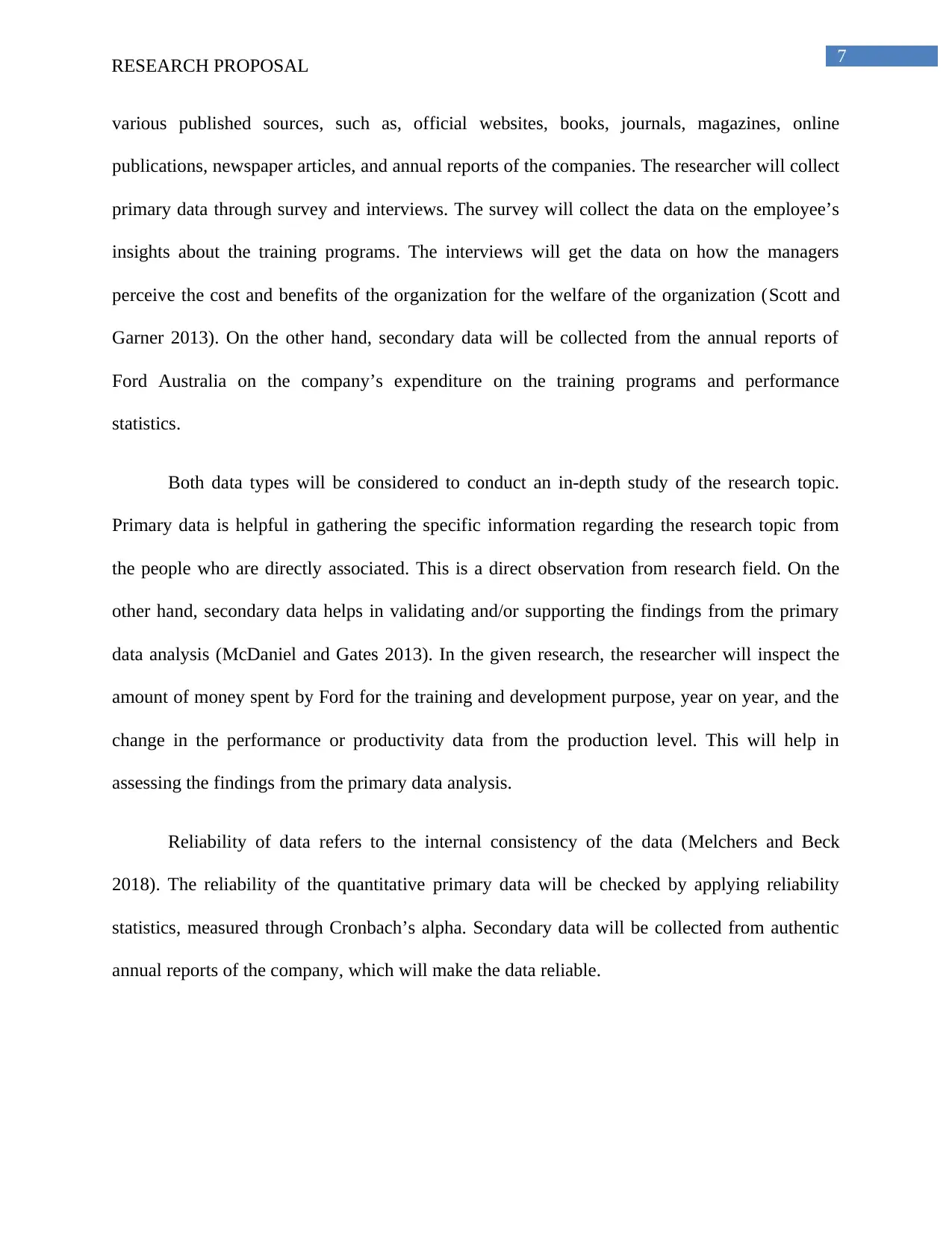
7RESEARCH PROPOSAL
various published sources, such as, official websites, books, journals, magazines, online
publications, newspaper articles, and annual reports of the companies. The researcher will collect
primary data through survey and interviews. The survey will collect the data on the employee’s
insights about the training programs. The interviews will get the data on how the managers
perceive the cost and benefits of the organization for the welfare of the organization (Scott and
Garner 2013). On the other hand, secondary data will be collected from the annual reports of
Ford Australia on the company’s expenditure on the training programs and performance
statistics.
Both data types will be considered to conduct an in-depth study of the research topic.
Primary data is helpful in gathering the specific information regarding the research topic from
the people who are directly associated. This is a direct observation from research field. On the
other hand, secondary data helps in validating and/or supporting the findings from the primary
data analysis (McDaniel and Gates 2013). In the given research, the researcher will inspect the
amount of money spent by Ford for the training and development purpose, year on year, and the
change in the performance or productivity data from the production level. This will help in
assessing the findings from the primary data analysis.
Reliability of data refers to the internal consistency of the data (Melchers and Beck
2018). The reliability of the quantitative primary data will be checked by applying reliability
statistics, measured through Cronbach’s alpha. Secondary data will be collected from authentic
annual reports of the company, which will make the data reliable.
various published sources, such as, official websites, books, journals, magazines, online
publications, newspaper articles, and annual reports of the companies. The researcher will collect
primary data through survey and interviews. The survey will collect the data on the employee’s
insights about the training programs. The interviews will get the data on how the managers
perceive the cost and benefits of the organization for the welfare of the organization (Scott and
Garner 2013). On the other hand, secondary data will be collected from the annual reports of
Ford Australia on the company’s expenditure on the training programs and performance
statistics.
Both data types will be considered to conduct an in-depth study of the research topic.
Primary data is helpful in gathering the specific information regarding the research topic from
the people who are directly associated. This is a direct observation from research field. On the
other hand, secondary data helps in validating and/or supporting the findings from the primary
data analysis (McDaniel and Gates 2013). In the given research, the researcher will inspect the
amount of money spent by Ford for the training and development purpose, year on year, and the
change in the performance or productivity data from the production level. This will help in
assessing the findings from the primary data analysis.
Reliability of data refers to the internal consistency of the data (Melchers and Beck
2018). The reliability of the quantitative primary data will be checked by applying reliability
statistics, measured through Cronbach’s alpha. Secondary data will be collected from authentic
annual reports of the company, which will make the data reliable.
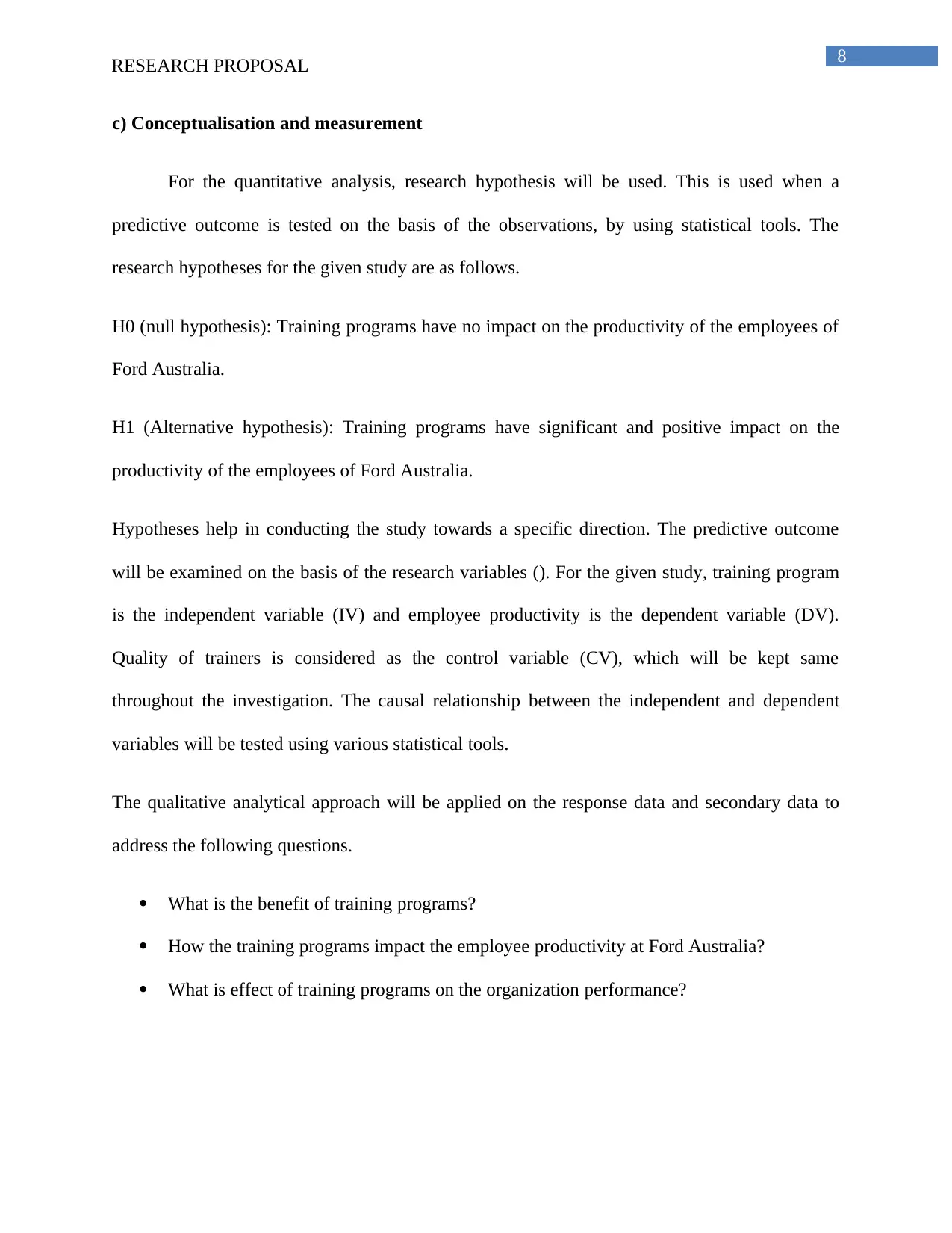
8RESEARCH PROPOSAL
c) Conceptualisation and measurement
For the quantitative analysis, research hypothesis will be used. This is used when a
predictive outcome is tested on the basis of the observations, by using statistical tools. The
research hypotheses for the given study are as follows.
H0 (null hypothesis): Training programs have no impact on the productivity of the employees of
Ford Australia.
H1 (Alternative hypothesis): Training programs have significant and positive impact on the
productivity of the employees of Ford Australia.
Hypotheses help in conducting the study towards a specific direction. The predictive outcome
will be examined on the basis of the research variables (). For the given study, training program
is the independent variable (IV) and employee productivity is the dependent variable (DV).
Quality of trainers is considered as the control variable (CV), which will be kept same
throughout the investigation. The causal relationship between the independent and dependent
variables will be tested using various statistical tools.
The qualitative analytical approach will be applied on the response data and secondary data to
address the following questions.
What is the benefit of training programs?
How the training programs impact the employee productivity at Ford Australia?
What is effect of training programs on the organization performance?
c) Conceptualisation and measurement
For the quantitative analysis, research hypothesis will be used. This is used when a
predictive outcome is tested on the basis of the observations, by using statistical tools. The
research hypotheses for the given study are as follows.
H0 (null hypothesis): Training programs have no impact on the productivity of the employees of
Ford Australia.
H1 (Alternative hypothesis): Training programs have significant and positive impact on the
productivity of the employees of Ford Australia.
Hypotheses help in conducting the study towards a specific direction. The predictive outcome
will be examined on the basis of the research variables (). For the given study, training program
is the independent variable (IV) and employee productivity is the dependent variable (DV).
Quality of trainers is considered as the control variable (CV), which will be kept same
throughout the investigation. The causal relationship between the independent and dependent
variables will be tested using various statistical tools.
The qualitative analytical approach will be applied on the response data and secondary data to
address the following questions.
What is the benefit of training programs?
How the training programs impact the employee productivity at Ford Australia?
What is effect of training programs on the organization performance?
⊘ This is a preview!⊘
Do you want full access?
Subscribe today to unlock all pages.

Trusted by 1+ million students worldwide
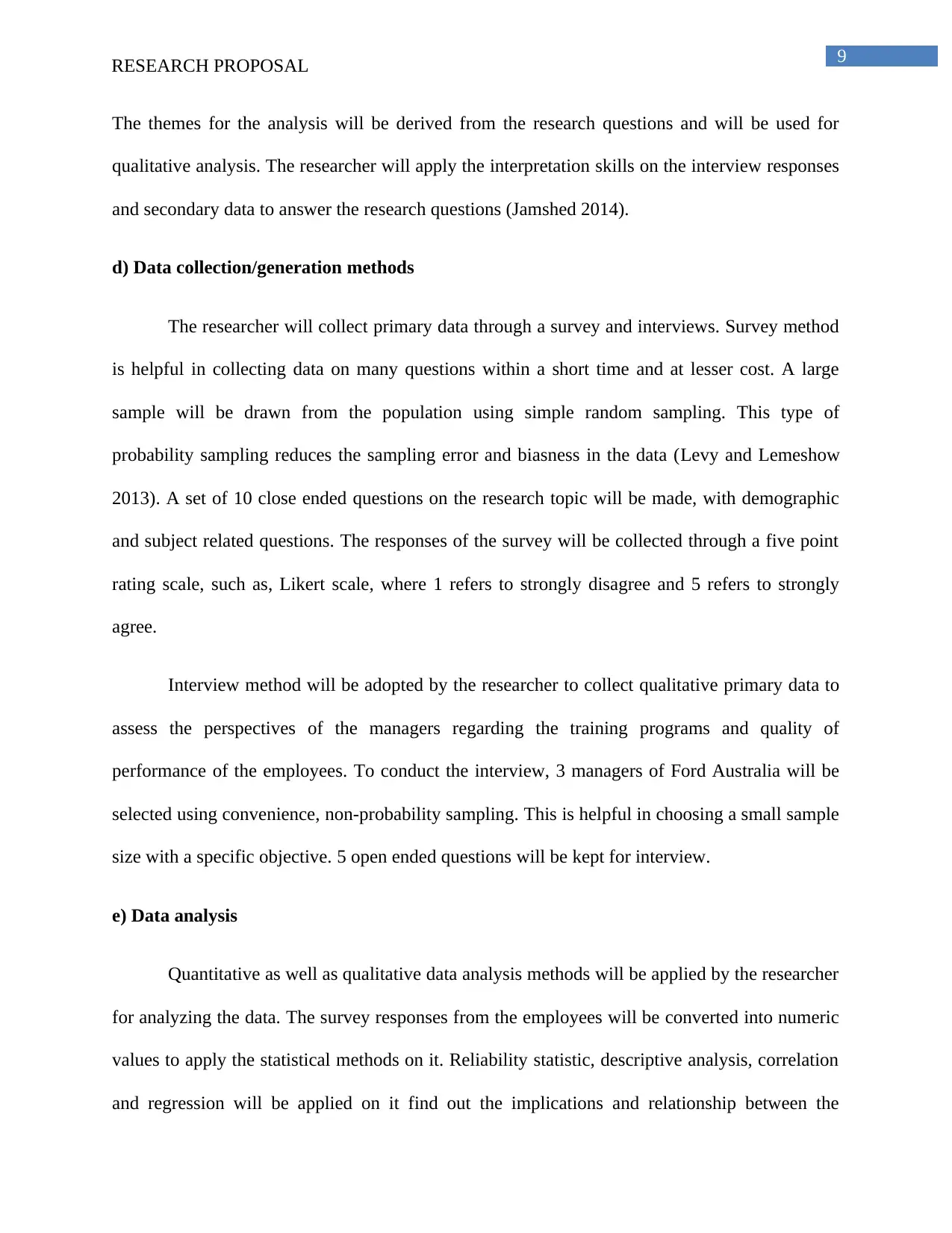
9RESEARCH PROPOSAL
The themes for the analysis will be derived from the research questions and will be used for
qualitative analysis. The researcher will apply the interpretation skills on the interview responses
and secondary data to answer the research questions (Jamshed 2014).
d) Data collection/generation methods
The researcher will collect primary data through a survey and interviews. Survey method
is helpful in collecting data on many questions within a short time and at lesser cost. A large
sample will be drawn from the population using simple random sampling. This type of
probability sampling reduces the sampling error and biasness in the data (Levy and Lemeshow
2013). A set of 10 close ended questions on the research topic will be made, with demographic
and subject related questions. The responses of the survey will be collected through a five point
rating scale, such as, Likert scale, where 1 refers to strongly disagree and 5 refers to strongly
agree.
Interview method will be adopted by the researcher to collect qualitative primary data to
assess the perspectives of the managers regarding the training programs and quality of
performance of the employees. To conduct the interview, 3 managers of Ford Australia will be
selected using convenience, non-probability sampling. This is helpful in choosing a small sample
size with a specific objective. 5 open ended questions will be kept for interview.
e) Data analysis
Quantitative as well as qualitative data analysis methods will be applied by the researcher
for analyzing the data. The survey responses from the employees will be converted into numeric
values to apply the statistical methods on it. Reliability statistic, descriptive analysis, correlation
and regression will be applied on it find out the implications and relationship between the
The themes for the analysis will be derived from the research questions and will be used for
qualitative analysis. The researcher will apply the interpretation skills on the interview responses
and secondary data to answer the research questions (Jamshed 2014).
d) Data collection/generation methods
The researcher will collect primary data through a survey and interviews. Survey method
is helpful in collecting data on many questions within a short time and at lesser cost. A large
sample will be drawn from the population using simple random sampling. This type of
probability sampling reduces the sampling error and biasness in the data (Levy and Lemeshow
2013). A set of 10 close ended questions on the research topic will be made, with demographic
and subject related questions. The responses of the survey will be collected through a five point
rating scale, such as, Likert scale, where 1 refers to strongly disagree and 5 refers to strongly
agree.
Interview method will be adopted by the researcher to collect qualitative primary data to
assess the perspectives of the managers regarding the training programs and quality of
performance of the employees. To conduct the interview, 3 managers of Ford Australia will be
selected using convenience, non-probability sampling. This is helpful in choosing a small sample
size with a specific objective. 5 open ended questions will be kept for interview.
e) Data analysis
Quantitative as well as qualitative data analysis methods will be applied by the researcher
for analyzing the data. The survey responses from the employees will be converted into numeric
values to apply the statistical methods on it. Reliability statistic, descriptive analysis, correlation
and regression will be applied on it find out the implications and relationship between the
Paraphrase This Document
Need a fresh take? Get an instant paraphrase of this document with our AI Paraphraser
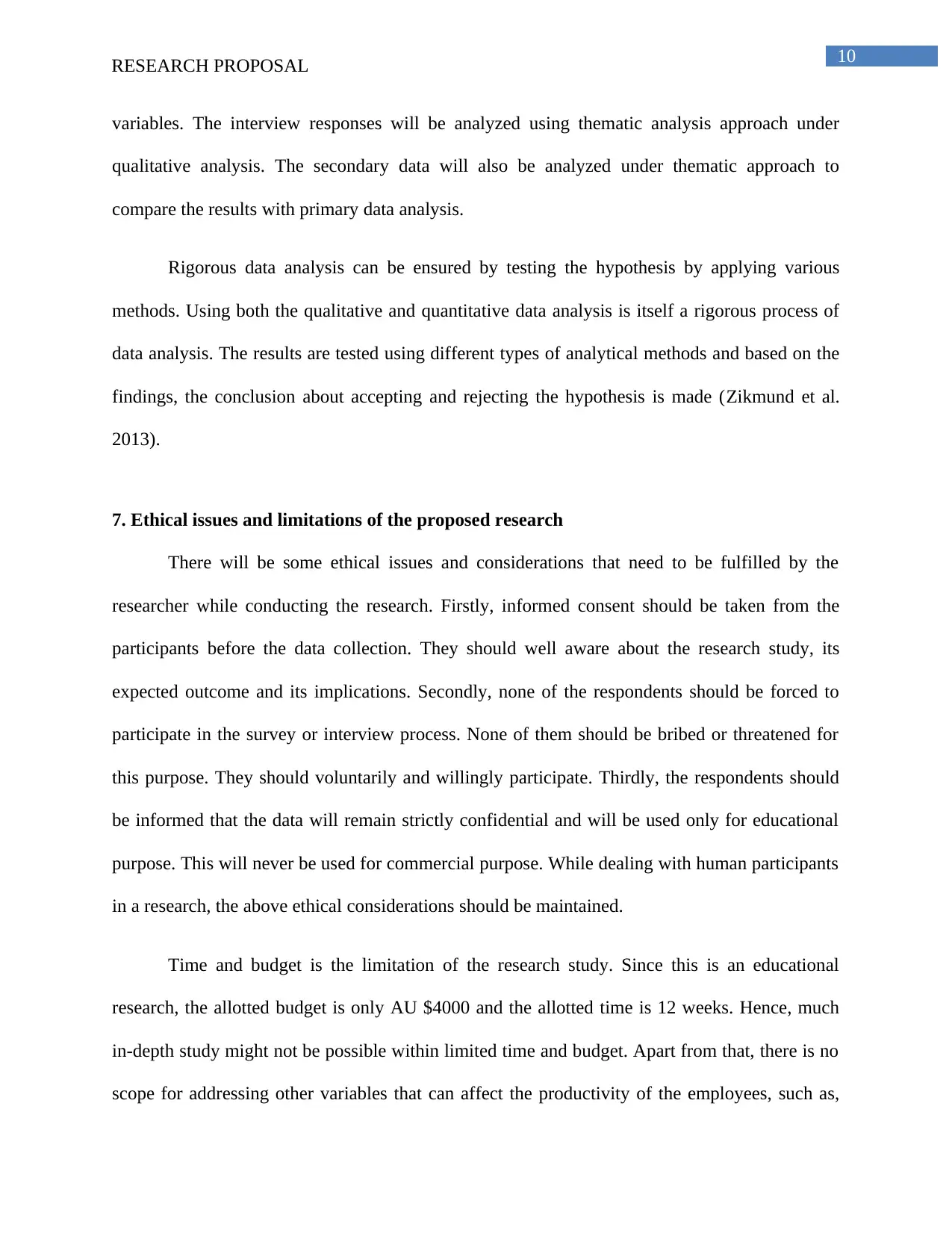
10RESEARCH PROPOSAL
variables. The interview responses will be analyzed using thematic analysis approach under
qualitative analysis. The secondary data will also be analyzed under thematic approach to
compare the results with primary data analysis.
Rigorous data analysis can be ensured by testing the hypothesis by applying various
methods. Using both the qualitative and quantitative data analysis is itself a rigorous process of
data analysis. The results are tested using different types of analytical methods and based on the
findings, the conclusion about accepting and rejecting the hypothesis is made (Zikmund et al.
2013).
7. Ethical issues and limitations of the proposed research
There will be some ethical issues and considerations that need to be fulfilled by the
researcher while conducting the research. Firstly, informed consent should be taken from the
participants before the data collection. They should well aware about the research study, its
expected outcome and its implications. Secondly, none of the respondents should be forced to
participate in the survey or interview process. None of them should be bribed or threatened for
this purpose. They should voluntarily and willingly participate. Thirdly, the respondents should
be informed that the data will remain strictly confidential and will be used only for educational
purpose. This will never be used for commercial purpose. While dealing with human participants
in a research, the above ethical considerations should be maintained.
Time and budget is the limitation of the research study. Since this is an educational
research, the allotted budget is only AU $4000 and the allotted time is 12 weeks. Hence, much
in-depth study might not be possible within limited time and budget. Apart from that, there is no
scope for addressing other variables that can affect the productivity of the employees, such as,
variables. The interview responses will be analyzed using thematic analysis approach under
qualitative analysis. The secondary data will also be analyzed under thematic approach to
compare the results with primary data analysis.
Rigorous data analysis can be ensured by testing the hypothesis by applying various
methods. Using both the qualitative and quantitative data analysis is itself a rigorous process of
data analysis. The results are tested using different types of analytical methods and based on the
findings, the conclusion about accepting and rejecting the hypothesis is made (Zikmund et al.
2013).
7. Ethical issues and limitations of the proposed research
There will be some ethical issues and considerations that need to be fulfilled by the
researcher while conducting the research. Firstly, informed consent should be taken from the
participants before the data collection. They should well aware about the research study, its
expected outcome and its implications. Secondly, none of the respondents should be forced to
participate in the survey or interview process. None of them should be bribed or threatened for
this purpose. They should voluntarily and willingly participate. Thirdly, the respondents should
be informed that the data will remain strictly confidential and will be used only for educational
purpose. This will never be used for commercial purpose. While dealing with human participants
in a research, the above ethical considerations should be maintained.
Time and budget is the limitation of the research study. Since this is an educational
research, the allotted budget is only AU $4000 and the allotted time is 12 weeks. Hence, much
in-depth study might not be possible within limited time and budget. Apart from that, there is no
scope for addressing other variables that can affect the productivity of the employees, such as,
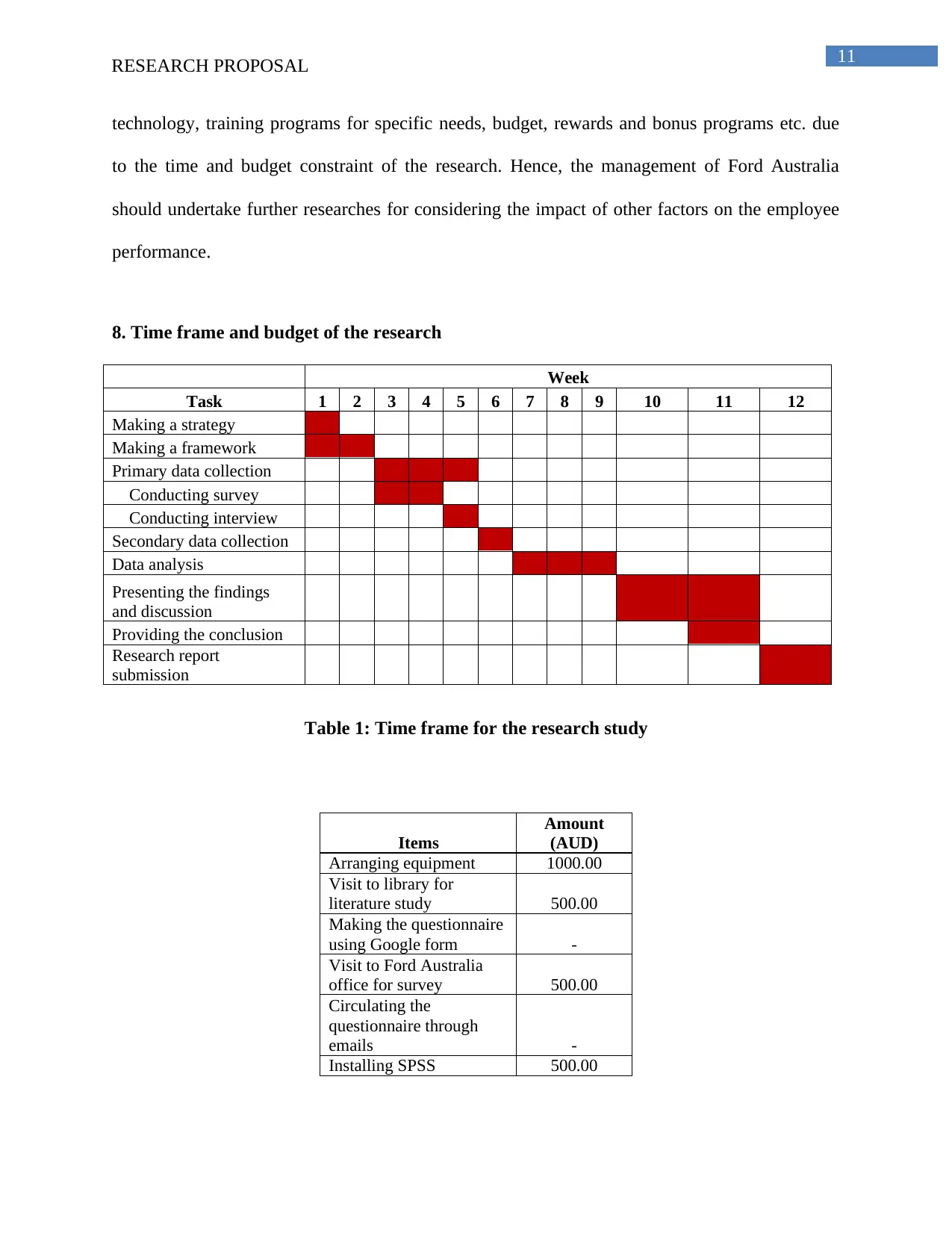
11RESEARCH PROPOSAL
technology, training programs for specific needs, budget, rewards and bonus programs etc. due
to the time and budget constraint of the research. Hence, the management of Ford Australia
should undertake further researches for considering the impact of other factors on the employee
performance.
8. Time frame and budget of the research
Week
Task 1 2 3 4 5 6 7 8 9 10 11 12
Making a strategy
Making a framework
Primary data collection
Conducting survey
Conducting interview
Secondary data collection
Data analysis
Presenting the findings
and discussion
Providing the conclusion
Research report
submission
Table 1: Time frame for the research study
Items
Amount
(AUD)
Arranging equipment 1000.00
Visit to library for
literature study 500.00
Making the questionnaire
using Google form -
Visit to Ford Australia
office for survey 500.00
Circulating the
questionnaire through
emails -
Installing SPSS 500.00
technology, training programs for specific needs, budget, rewards and bonus programs etc. due
to the time and budget constraint of the research. Hence, the management of Ford Australia
should undertake further researches for considering the impact of other factors on the employee
performance.
8. Time frame and budget of the research
Week
Task 1 2 3 4 5 6 7 8 9 10 11 12
Making a strategy
Making a framework
Primary data collection
Conducting survey
Conducting interview
Secondary data collection
Data analysis
Presenting the findings
and discussion
Providing the conclusion
Research report
submission
Table 1: Time frame for the research study
Items
Amount
(AUD)
Arranging equipment 1000.00
Visit to library for
literature study 500.00
Making the questionnaire
using Google form -
Visit to Ford Australia
office for survey 500.00
Circulating the
questionnaire through
emails -
Installing SPSS 500.00
⊘ This is a preview!⊘
Do you want full access?
Subscribe today to unlock all pages.

Trusted by 1+ million students worldwide
1 out of 16
Related Documents
Your All-in-One AI-Powered Toolkit for Academic Success.
+13062052269
info@desklib.com
Available 24*7 on WhatsApp / Email
![[object Object]](/_next/static/media/star-bottom.7253800d.svg)
Unlock your academic potential
Copyright © 2020–2025 A2Z Services. All Rights Reserved. Developed and managed by ZUCOL.





